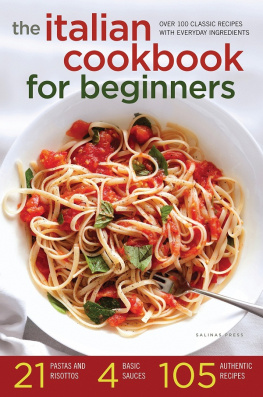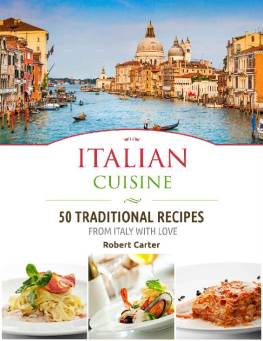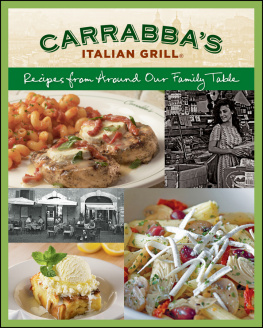TO MOM, WHO TAUGHT ME THAT THE RECIPE FOR SUCCESS IS TO FOLLOW YOUR HEART. THIS BOOK IS JUST AS MUCH A PART OF YOU; MAY YOUR MEMORY LIVE ON THROUGH THESE PAGES. MP

To buy books in quantity for corporate use or incentives, call (800) 962-0973 or e-mail premiums@GlobePequot.com.
Copyright 2010 by Melissa Pellegrino and Matthew Scialabba
ALL RIGHTS RESERVED. No part of this book may be reproduced or transmitted in any form by any means, electronic or mechanical, including photocopying and recording, or by any information storage and retrieval system, except as may be expressly permitted in writing from the publisher. Requests for permission should be addressed to Globe Pequot Press, Attn: Rights and Permissions Department, P.O. Box 480, Guilford, CT 06437.
ThreeForks is a registered trademark of Morris Book Publishing, LLC.
Photos by Melissa Pellegrino and Matthew Scialabba
Project editor: Jessica Haberman
Text design: Sheryl P. Kober
Layout artist: Nancy Freeborn
Maps: M. A. Dub Morris Book Publishing, LLC
Library of Congress Cataloging-in-Publication Data
Scialabba, Matthew.
Italian farmers table : authentic recipes and local lore from northern Italy / Matthew Scialabba and Melissa Pellegrino.
p. cm.
ISBN 978-0-7627-5264-5
1. Cookery, ItalianNorthern style. 2. FarmsRecreational useItaly. I. Pellegrino, Melissa. II. Title.
TX723.2.N65S34 2009
641.5945'1dc22
2009018501
Printed in China
10 9 8 7 6 5 4 3 2 1
ACKNOWLEDGMENTS
Tra il dire e il fare c di mezzo il mare.
Between saying and doing lies half the ocean.
We first heard this Italian proverb while living in Rome together, and at the time we thought very little of it except that it had a nice poetic ring to it. Seven years later, this expression has been the foundation for our perseverance on this project, which led us to Italy to pursue our dream of writing this cookbook. We extend our deepest gratitude to everyone who believed in us and our project along the way.
This book would not have been possible without the generosity and enthusiasm of each farm. A heartfelt thanks to everyone at La Giara, Giandriale, Terre Bianche, Tra Sole e Vigne, La Traversina, Ca Villa, La Quercia Rossa, La Miniera, La Capuccina, Les Ecureuils, Maison Rosset, Plan de la Tour, Cascina Caremma, La Ribunta, Casa Clelia, Macesina, Baite di Pra, Casa al Campo, Glinzhof, Perusini, La Subida, Casale Cjanor, I Comelli, Rechsteiner, Le Vescovane, Corte Verze, Le Occare, Cavazzone, Fattoria Paradiso, and Ca dAlfieri. We were welcomed into these peoples lives and kitchens to learn all that they had to share.
To our moms: Barb and Karen, for all of your support and assistance in the kitchen.
To our fathers: Fran and Jim, for always providing the wine and hearty appetites.
To our brothers and sisters: Bryan, Chris, Jeff, Lindsey, and Steph.
To Japhy, who is always hungry.
To Jonathan Teller-Elsberg, for being the first to believe.
To Brian Buckley, who has always been there for advice.
To Moe and Tastebuds, mere words are not enough to thank you for everything you have done.
To Jim and Deb Cianciolo, for your passion for good food and wine.
To Antonio, for always giving us a home in Italy.
To Bishops, Fortes Market, and Star Fish Market, for your superior products in a small town like Guilford, Connecticut.
To Heather and Scott, for giving us a chance and keeping it local.
To Jess Haberman and everyone at GPP, for making this look so good.

INTRODUCTION

AGRITURISMI
Small family farms are the face and backbone of rural Italy. Their picturesque stone farmhouses and manicured fields create a beautiful landscape whose bounty represents the soul of regional Italian cuisine. The agriturismi system was developed by the Italian government in 1985 to help preserve these farms throughout the country. Allowing farm owners to open their doors to overnight guests and provide them with meals helps these small farms supplement their incomes and continue living off the land. Strict laws mandate that a certain percentage of the food served be grown on the property, with all other ingredients sourced from nearby farms. Sustainability and dedication to a farm-fresh cuisine created by the seasons are the two most common threads linking these farms. A meal at an agriturismo speaks volumes more than mere satiation, for there is a story behind every ingredient used in a finished and plated dish. Are the vegetables grown outdoors in nutrient-rich soil or beneath the glow of artificial heat? Are they cultivated in verdant green pastures or in a windowless shed? Knowing and controlling these circumstances are fundamental principles of the agriturismi philosophy. The food agriturismi serve is the final result of their commitment and dedication to working their land. The tomatoes started as seeds dried from last years harvest, the summer-milk cheese from cattle fed fresh flowers and herbs, the olive oils vibrant green color from barely pressed organic olives: All of these factors, revealing the underlying superiority and goodness of farm-fresh ingredients, show why it is so beneficial to cook with locally grown products. In addition to agriculture, many agriturismi have taken sustainability a step further by going off the grid, producing their own energy with fuel sources cultivated from their surroundings. It is a proactive approach toward a viable and economical alternative to traditional living, utilizing local resources for a low-impact, earth-friendly lifestyle. Today, the agriturismi movement is booming, as thousands of abandoned farms across the country have undergone an agrarian revolution. Beautiful old farmhouses, once left to crumble and decay, have been restored to splendor and now offer country retreats for tourists seeking rural solace and tranquility in the Italian countryside and a cuisine not readily found in cities and towns.
OUR EXPERIENCES
While on a vacation in southern Tuscany some years ago, we found ourselves driving aimlessly at dusk. Lost, hungry, and without accommodations for the night, we followed a dark and winding road into the countryside with only the rumblings from our stomachs to pierce the silence around us. Suddenly, around a turn, we spotted a magnificent stone farmhouse on a hill, bathed in light and surrounded by tall cypress trees. Farther down the road, we passed a sign that read agriturismo and had a symbol of a bed and a plate, fork, and knife. Was some kind of guardian angel leading us to this oasis in the thick of the black Tuscan night? Pulling into the driveway, we noticed cars with license plates from all over Europe. We approached the large antique wooden door with eager anticipation of what awaited us inside and opened it slowly. Wonderful aromas, laughter, and the joyous sounds of people having a good time engulfed us. A beautiful dining room lay before us, with diners enjoying numerous plates of delicious-looking food at long wooden tables. Immediately we felt warm, welcomed, and very hungry. Im sorry, signori, but we are completely full tonight, a voice said from behind us. Please take our card and reserve the next time you are traveling through. Thus went our first experience with Italian agriturismi.
After graduating from culinary school, we desired a hands-on experience where we could continue our education and share a direct connection with the ingredients we use in the kitchen. Remembering that fateful night in Tuscany, we contacted several agriturismi and spent a year working in the fields and kitchens of farms throughout central Italy. Upon returning to the States, the uniqueness of our experiences began to sink in. The simple daily tasks of walking into the fields to gather vegetables from the garden for the nights meal, venturing into the chicken coop to search for eggs to make fresh pasta, and heading down into the cantina to fill carafes with wine from large wooden barrels, were all replaced with the giant urban supermarkets of home. While the reveries of our Italian farm life eventually waned, the farm philosophies and approaches toward cooking had planted a seed about the importance of knowing where our food comes from. As we soon discovered, a movement to support local farms was underway in America, signaled by the sudden surge in popularity of farmers markets. We realized we could rekindle our Italian agriturismi days and cook using fresh native ingredients, and by conversing with the growers, we could share a connection with the land through the food we were eating. Our year at the farms revealed our passion for local and organic products in conversations with others, and tales of our travels helped sparked interest in the Italian countryside lifestyle. As two chefs, we thought that a cookbook would be the perfect way to bring these farms to life.











 INTRODUCTION
INTRODUCTION 